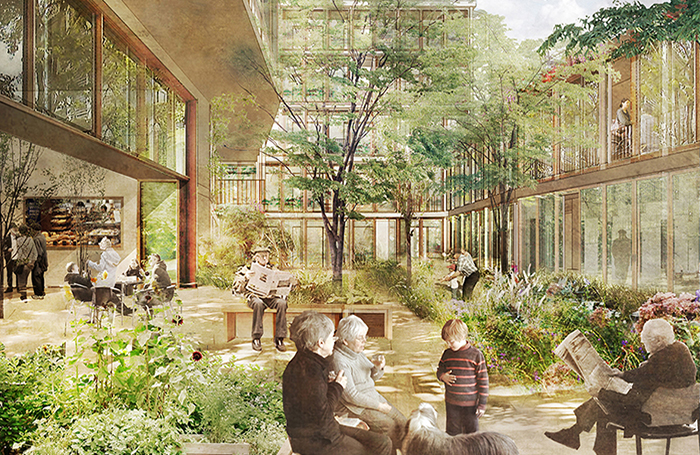The demographic landscape of our cities is changing fast, as our cities grow and the population ages. But how do architects respond to the challenge? How do we go about creating more ‘age-inclusive’ spaces? And are there ways we can cultivate a design sensibility more sensitive to the desires and needs of an ageing population?

Throughout 2014 The RIBA collated a vast amount of existing knowledge from architects, other built environment professionals, academics and other researchers about design for older people. There are a large number of documents so we asked a selection of experts to write introductions for a number of key themes - primers that architects can use in practice or use as a starting point for their exploration of the detailed research.
When faced with all the information on design it’s hard to know where to start; that’s why the RIBA has asked experts from practices and beyond to write a series of introductions to key themes.
Each item of evidence in the database sits at the intersection of two categorisations: the design approach (health and wellbeing, inclusion, and sustainability) and project scale (from residential to masterplanning). Where these intersect we’ve asked the experts to write an introduction, which can be found in the document below.
Health and Wellbeing
Perhaps unsurprisingly, research and evidence related to health and wellbeing was most prevalent in the material collected.
Inclusion
Information about access and social inclusion includes issues related to preventing loneliness, which can be a scourge of older age, which can also relate to health and wellbeing.
Sustainability
Environmental, social and economic issues, such as daylight, building services and fuel poverty.
The introductions, downloadable as a PDF, give a brief overview of important, interesting and useful points from the evidence base. They’re a good place to start your exploration of the subject, but you may find you want to delve deeper. To help with this we’ve saved details of all the evidence on the (free) bibliographic database Zotero, and have tagged all the evidence with key terms so it’ll be easy to find what you are looking for.
Download the Experts Introductions to Ageing Research
View the RIBA Design for an ageing population knowledge base
Call
In doing the review of evidence the RIBA’s primary goal was to help its members – and other built environment professions – to access the relevant and new knowledge they need to create buildings and places that meet the needs of an ageing society.
If the profession is to continue to innovate it is critical that the reach of both academic and practice-based research increases. If practitioners are to find out about and use techniques such as participatory or collaborative co-production of design – which are gaining traction within groups undertaking inclusive design and design for older people – the rift between practice and research needs to be healed.
We’re keen to encourage young architects to engage with design for older people early in their career – which is why we’re pleased that a number of groups and schools are in contact with the RIBA and an informal student network is developing that should equip a cohort of architects with the skills and knowledge necessary to create the age-friendly places we need.
State of research
The items in the knowledge collection were collated over the course of a year with the majority submitted in early 2014. Larger research projects generally came from University partnerships, with some practice based support. Peer reviewed papers came entirely from academics and case studies came from academic-practice partnerships or directly from practices. Guidance for practitioners has been developed primarily by practicing professionals either in conjunction with professional bodies, universities or occasionally public bodies.
There is comparatively very little research from practice however some of the practice led research featuring some academics) such as the HAPPI Report are well known, and anecdotally are cited by many practices as one of the papers they find most useful.
Gaps
In the evidence submitted there is (perhaps unsurprisingly) a focus on residential projects; general or sheltered (often for the over 55s) housing, extra-care, care homes and dementia care. There is little research into outdoor spaces with regards to ageing and sustainability, and there is also very little on non-residential buildings – other than healthcare buildings – especially retail, leisure, civic and workplaces.
The RIBA encourages new research in these areas. Older people should not have to remain at home because other buildings and spaces have not been designed with their needs in mind, nor (in a world where the retirement ages are steadily increasing) should workplaces exclude valuable members of the workforce.
Please email research@riba.org for information about how the RIBA could support your research.
Methods
Potential visions of the near future – in which an increased cohort of the ‘active Third Age’ has begun to have an impact on our towns and cities – was set out in the October 2013 RIBA publication ‘Silver Linings: The Active Third Age and the City’. Predictions related to demographic change highlight the scale of social change that the UK will face: between 2013 and 2017 the number of people aged 80 and over is projected to more than double to 6 million by mid-2037, with the number of people of pensionable age increasing by 31 per cent (ONS, 2013).
The changing structure of society, coupled with population growth, means that architects will have many new design challenges to grapple with. To help the profession – and other involved with the creation of the built environment – to respond the RIBA embarked on a project to collect evidence related to design for ageing. A call for evidence was released in late 2013, and over the course of 2014 over 450 items of research, guidance, case studies and other publications were collated.
Bibliographic information for the resulting collection can be found in a Zotero (online bibliographic tool) database. Links to many items are available through the database, but some items are books or aren’t open access, but may be accessed through specialist libraries, such as the RIBA library or university libraries. The items collated have not been formally graded for quality, but the authors of the theme introductions have highlighted the work they believe to be the most significant.
The Housing Learning and Improvement Network (www.housinglin.org.uk) has been invaluable in its support for the RIBA project. The network maintains up-to-date case studies and viewpoints from across the industry, and runs informative events and conferences nationwide.
While every effort has been made to check the accuracy and quality of the information given in this publication, neither the RIBA nor the introduction authors accept any responsibility for the subsequent use of this information, for any errors or omissions that it may contain, or for any misunderstandings arising from it.









